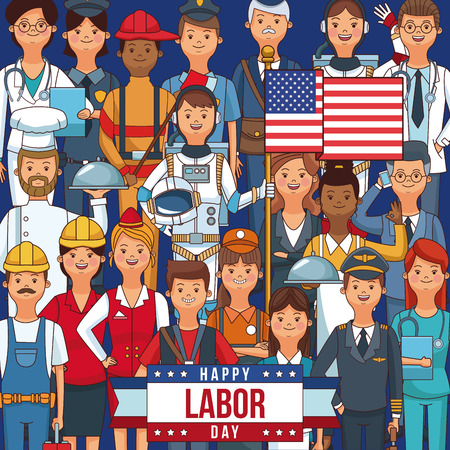Introduction to Multigenerational Workforces in the U.S.
The modern American workplace is more generationally diverse than ever before. Today, it’s common for companies to have employees from four or even five different generations collaborating on the same teams. These groups often include Traditionalists (born before 1946), Baby Boomers (1946-1964), Generation X (1965-1980), Millennials (1981-1996), and Generation Z (1997 and after). Each generation brings unique perspectives, work habits, communication styles, and values to the table, all of which can influence how teams operate and achieve their goals.
In American companies, this diversity is not just a demographic reality—it’s a strategic asset. When managed effectively, multigenerational teams can drive innovation, increase productivity, and create more inclusive solutions that reflect the needs of a broad customer base. However, bridging the gaps between generations also presents challenges, such as differences in technology adoption, feedback preferences, and approaches to work-life balance.
Generational Diversity in Numbers
| Generation | Birth Years | Key Traits |
|---|---|---|
| Traditionalists | Before 1946 | Loyalty, discipline, respect for authority |
| Baby Boomers | 1946-1964 | Team orientation, strong work ethic, competitive |
| Generation X | 1965-1980 | Independence, adaptability, pragmatism |
| Millennials | 1981-1996 | Tech-savvy, value collaboration, purpose-driven |
| Generation Z | 1997 & after | Digital natives, entrepreneurial mindset, diversity-focused |
Impact on Teamwork and Business Outcomes
This generational mix can impact teamwork dynamics in various ways. For example, older employees may prefer face-to-face meetings while younger colleagues lean toward digital communication tools. At the same time, multigenerational teams can leverage a wider range of skills and experiences to solve problems creatively and make decisions with broader perspectives. Research consistently shows that companies embracing generational diversity are better positioned to adapt to change, retain talent, and perform well in highly competitive markets.
2. Key Challenges in Multigenerational Collaboration
When American companies assemble teams composed of Baby Boomers, Generation X, Millennials, and Gen Z employees, they often encounter unique challenges that can impact overall performance. One of the most common obstacles is the communication gap. Different generations tend to prefer distinct modes of communication—for example, Baby Boomers might favor phone calls or face-to-face meetings, while Millennials and Gen Z are more likely to use instant messaging or collaborative digital platforms. These differences can lead to misunderstandings or missed messages, making it harder for teams to stay aligned.
Common Obstacles Encountered by Multigenerational Teams
| Challenge | Description | Impact on Teamwork |
|---|---|---|
| Communication Styles | Varied preferences for email, phone, in-person, or chat tools across generations. | Miscommunication and slower information flow. |
| Work Styles | Differing attitudes towards work hours, remote work, and task management. | Conflicts over flexibility, productivity expectations, and accountability. |
| Technology Adoption | Younger generations may adopt new technologies faster than older colleagues. | Inefficiencies or frustration when introducing new systems or tools. |
| Feedback Preferences | Some generations prefer formal reviews; others value real-time feedback. | Dissatisfaction with recognition and growth opportunities. |
Cultural Differences in the American Workplace
In the context of American companies, workplace culture further shapes how these generational differences play out. For instance, U.S. workplaces often emphasize individuality and innovation—a value more easily embraced by younger employees but sometimes at odds with the traditional hierarchical approach favored by older generations. Balancing respect for experience with the desire for fresh perspectives is a continual challenge that requires intentional leadership and inclusive practices.

3. Successful Strategies Employed by Leading U.S. Companies
American organizations have adopted a variety of practical strategies to overcome generational gaps and encourage productive teamwork. These methods focus on leveraging the unique strengths of each generation, enhancing communication, and building a culture of respect and inclusion. The following table highlights some real-world tactics used by prominent U.S. companies:
| Company | Strategy | Implementation Example |
|---|---|---|
| Reverse Mentoring | Younger employees mentor senior staff on digital trends, while senior staff share industry knowledge. | |
| Dell Technologies | Flexible Work Arrangements | Offers remote work and flexible hours to meet the needs of all age groups. |
| The Home Depot | Cross-Generational Team Projects | Teams are intentionally mixed across generations for innovation initiatives. |
Open Communication Channels
Leading companies prioritize transparent communication by implementing open-door policies, regular feedback sessions, and digital collaboration tools like Slack or Microsoft Teams. This ensures everyone’s voice is heard, regardless of age or position, fostering mutual understanding and minimizing misunderstandings stemming from generational differences.
Recognition and Inclusion Programs
To further bridge generational divides, many American firms have launched recognition programs that celebrate achievements across all age groups. For example, “Employee of the Month” awards and peer-nominated accolades highlight contributions from both seasoned professionals and newer team members, reinforcing a sense of value and belonging.
Continuous Learning Opportunities
U.S. companies often provide ongoing training that appeals to different learning styles. This includes online courses for tech-savvy younger workers and in-person workshops for those who prefer face-to-face engagement. By investing in diverse professional development opportunities, organizations ensure every generation can thrive and contribute their best to collaborative efforts.
4. Case Study: Google’s Age-Inclusive Project Teams
Google has long been recognized for its innovative approach to team building, and one area where it stands out is its deliberate inclusion of multiple generations in project teams. By purposefully blending employees from different age groups—ranging from Gen Z interns to Baby Boomer engineers—Google fosters a collaborative environment that leverages the unique strengths of each generation.
The Formation Process
Google’s People Operations team uses data-driven strategies to assemble age-diverse project groups. This process includes analyzing employees’ skillsets, experience levels, and even preferred working styles to create balanced teams. The goal is not only to enhance creativity but also to ensure that knowledge transfer occurs organically within daily workflows.
Key Elements of Google’s Approach
| Element | Description |
|---|---|
| Intentional Team Composition | Teams are formed with a conscious effort to include members from at least three different generations. |
| Cross-Generational Mentoring | Formal mentorship programs pair younger and older employees for mutual learning and support. |
| Flexible Communication Channels | Adoption of both digital tools (like Slack) and traditional meetings to cater to diverse preferences. |
| Continuous Feedback Loops | Regular check-ins allow team members to share feedback and adjust collaboration styles as needed. |
Results Achieved by Age-Inclusive Teams at Google
The impact of these age-inclusive teams has been significant. According to internal studies, projects managed by multigenerational groups at Google have shown higher rates of innovation and faster problem-solving compared to more homogenous teams. Employees report greater job satisfaction and a stronger sense of belonging, which aligns with Google’s broader mission of building an inclusive workplace culture.
Outcomes at a Glance
| Metric | Multigenerational Teams | Single-Generation Teams |
|---|---|---|
| Innovation Rate Increase | +18% | – |
| Problem-Solving Speed Improvement | +22% | – |
| Employee Satisfaction Score | 91/100 | 79/100 |
| Sustained Knowledge Transfer | Consistent across cycles | Sporadic or limited |
This case study demonstrates how American companies like Google are leading the way in harnessing the power of multigenerational teamwork, ultimately driving better business outcomes while cultivating a more dynamic and supportive work environment.
5. Case Study: Procter & Gamble’s Reverse Mentoring Initiatives
Procter & Gamble (P&G), a renowned American multinational, has distinguished itself through innovative multigenerational teamwork strategies, particularly with its reverse mentoring initiatives. In contrast to traditional mentoring—where senior employees guide younger staff—reverse mentoring flips the dynamic, allowing younger professionals to mentor seasoned colleagues, especially in areas like digital technology and emerging social trends.
Analysis of P&G’s Approach to Reverse Mentoring
P&G’s program was designed to bridge generational gaps by leveraging the strengths of each age group. The initiative started as a pilot within the marketing and IT departments, where rapid digital transformation demanded new skills and perspectives. Younger employees, often digital natives, were paired with senior leaders who had deep institutional knowledge but less familiarity with cutting-edge tech or evolving consumer behaviors.
Program Structure and Goals
| Element | Description |
|---|---|
| Mentor Demographics | Millennial and Gen Z employees (under 35) |
| Mentee Demographics | Senior leaders (Gen X and Boomers) |
| Focus Areas | Digital marketing, social media trends, tech adoption |
| Key Objectives | Cultural exchange, mutual learning, faster innovation cycle |
Impact on Workplace Learning and Engagement
The results of P&G’s reverse mentoring have been notable. Surveys conducted internally showed increased engagement scores across all age groups after participating in the program. Senior leaders reported higher confidence in using new technologies, while younger mentors gained a deeper understanding of corporate strategy and leadership challenges. The initiative also fostered a culture of continuous learning and mutual respect among different generations.
Key Outcomes Observed at P&G
- Enhanced Digital Skills: Older employees adopted new tools more rapidly.
- Younger Employees’ Empowerment: Increased job satisfaction due to visible impact on company processes.
- Cross-Generational Collaboration: Projects saw improved creativity and problem-solving from diverse input.
- Cultural Shift: A more inclusive atmosphere where every generation feels valued for their unique contributions.
P&G’s reverse mentoring initiatives serve as a model for American companies seeking to harness the potential of multigenerational teams. By facilitating two-way learning, organizations can unlock higher engagement, agility, and innovation—key drivers for sustained success in today’s fast-evolving marketplace.
6. Lessons Learned and Best Practices
The case studies of successful multigenerational teamwork in American companies reveal several key takeaways that can be translated into actionable strategies for other U.S. organizations. These lessons emphasize the importance of intentional leadership, open communication, and adaptive workplace policies. Below are the primary insights and best practices:
Key Takeaways from the Case Studies
| Lesson | Best Practice | Example Application |
|---|---|---|
| Intentional Cross-Generational Collaboration | Create structured opportunities for team members of different ages to collaborate on projects. | Mentorship programs pairing Gen Z with Baby Boomers for mutual learning. |
| Customized Communication Styles | Encourage teams to adapt communication methods based on generational preferences. | Offering both digital platforms (Slack, Teams) and in-person meetings. |
| Inclusive Decision-Making | Solicit input from all age groups when making team or company-wide decisions. | Intergenerational focus groups for new policy rollouts. |
| Continuous Learning Opportunities | Provide training that addresses skills gaps unique to each generation. | Tech upskilling sessions for older employees; soft skills workshops for younger staff. |
| Recognition and Flexibility | Acknowledge contributions across generations and offer flexible work arrangements. | Diverse recognition programs and hybrid work options tailored to individual needs. |
Actionable Insights for U.S. Companies
- Cultivate a Culture of Respect: Proactively address generational stereotypes through DEI initiatives and regular team-building exercises that highlight shared values rather than differences.
- Leverage Technology Thoughtfully: Implement user-friendly tools and provide support so all generations feel empowered, not alienated, by digital solutions.
- Foster Reverse Mentoring: Encourage younger employees to share digital expertise while senior staff impart industry knowledge, creating reciprocal learning relationships.
- Reevaluate Benefits Packages: Offer a menu of benefits—such as student loan repayment assistance or phased retirement—to meet the diverse needs of a multigenerational workforce.
- Set Clear Expectations: Develop transparent guidelines regarding roles, responsibilities, and feedback processes to align expectations across age groups.
The Bottom Line
The most successful American companies recognize that effective multigenerational teamwork is a strategic asset. By drawing on these key lessons and best practices, organizations can unlock higher productivity, greater innovation, and stronger employee satisfaction—ensuring that every generation’s strengths contribute to long-term success.


